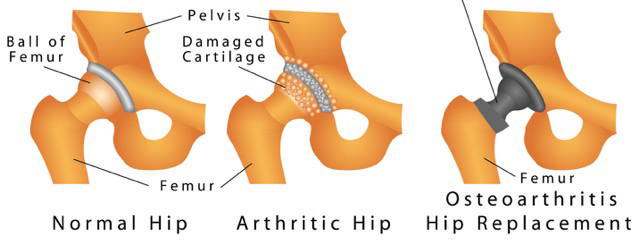The Next Step: Hip Replacement Surgery

If common activities like walking and getting in and out of a chair become difficult and painful and medications, changes in everyday activities, and walking supports do not relieve the symptoms, hip replacement surgery may be the next step.
The Anatomy of the Hip
The hip, a ball-and-socket joint, is one of the body’s largest joints. The ball is the femoral head, the upper end of the femur, thighbone. The socket is formed by the acetabulum, part of the large pelvis bone. The bone surfaces are covered with articular cartilage, cushioning the bones for ease of movement. A thin tissue called synovial membrane surrounds the hip joint and lubricates the cartilage, eliminating friction during hip movement. Ligaments connect the ball to the socket and provide stability to the joint. People who benefit from hip replacement surgery suffer from symptoms including:
- Hip pain that limits everyday activities, such as walking or bending
- Hip pain that continues while resting
- Stiffness in a hip that limits the ability to move or lift the leg
- Inadequate pain relief from anti-inflammatory drugs, physical therapy or walking supports
The most common cause of chronic hip pain and disability is osteoarthritis, a degenerative joint disease. A lifetime of walking, exercising, and daily movement can take a toll on cartilage. The degeneration of cartilage covering the ends of the bones breaks down over time, causing the bones of the hip joint to rub together, which results in pain and stiffness.
Is Hip Replacement Surgery is Right for You?
The decision to have hip replacement surgery should be a cooperative one by the guest patient, his or her family, and the DOC orthopedic surgeon. An evaluation with the physician includes a guest’s medical history, a physical examination, X-rays, and possible MRI scan to determine the condition of the bone and soft tissues of the hip. Hip replacement surgery is a safe and effective procedure that can relieve pain, increase motion and enable the ability to perform everyday activities. First performed in 1960, hip replacement surgery is one of the most successful operations in all of medicine. Since 1960, improvements in joint replacement surgical techniques and technology have greatly increased the effectiveness of total hip replacement. According to the Agency for Healthcare Research and Quality, more than 300,000 total hip replacements are performed each year in the United States. Most patients who undergo total hip replacement are age 50 to 80, but DOC’s orthopedic surgeons evaluate patients individually. In a total hip replacement, hip arthroplasty, the damaged bone, and cartilage are removed and replaced with prosthetic components. Most people who undergo hip replacement surgery experience a dramatic reduction of hip pain and a significant improvement in their ability to perform the common activities of daily living. With appropriate activity modification, hip replacements can last for many years. To learn about other hip conditions treated by DOC, visit the page here.
For more information on the cost of care, click here.




